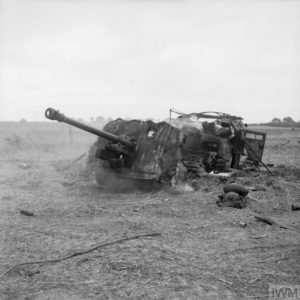Esquay-Notre-Dame (Calvados)
Hill 112
The cities of Normandy during the 1944 battles
On July 15, 1944, in the Hill 112 sector near Esquay-Notre-Dame, a British Quad Gun Tractor towing an Ordnance QF 17-pounder (76.2 mm) anti-tank gun was destroyed by German fire. Both the vehicle and the gun are now burning out. Photo : IWM B7439
- Liberation: 4 August 1944
- Deployed units:
![]() 11th Armoured Division
11th Armoured Division
![]() 15th (Scottish) Infantry Division
15th (Scottish) Infantry Division
![]() 43rd (Wessex) Infantry Division
43rd (Wessex) Infantry Division
![]() 9. SS-Panzer-Division « Hohenstaufen »
9. SS-Panzer-Division « Hohenstaufen »
![]() 10. SS-Panzer-Division « Frundsberg »
10. SS-Panzer-Division « Frundsberg »
- History:
The village of Esquay-Notre-Dame (in 1944 named simply “Esquay”) is located 11 kilometers as the crow flies from Caen. It is located on the southeast slope of a slight rise in the land, culminating at an altitude of 112 meters, overlooking both the Orne Valley and the Odon Valley. This height, now known as Hill 112, is dominated by the place called Les Filandriers. It is a truly key point in the surrounding area, whose control ensures freedom of action in the region south of Caen.
One month after the start of the Overlord Offensive, Anglo-Canadian forces were still unable to capture Caen and carried out a series of bloody operations to definitively push the Germans back. To this end, they attempted several times to bypass the city, but without success. On the early afternoon of June 28, during Operation Epsom, Hill 112 was first reached by infantrymen of the 8th Battalion, The Rifle Brigade, of the 11th Armoured Division, supported by tanks of the 3rd Royal Tank Regiment. However, the Germans of the 9th SS-Panzer Division counterattacked in the area and pushed their opponents further north, inflicting heavy losses and reoccupying Hill 112.
On July 10, 1944, Esquay was held by the 2nd Battalion, SS-Panzergrenadier Regiment 21 (9th SS-Panzer Division). The 3rd Battalion was installed in the Hill 112 sector, taking advantage of the view to identify Allied movements to the east and west of Caen, particularly in the Odon Valley sector where the British were seeking to establish a solid bridgehead. That same day at 5 a.m., a powerful Allied artillery fire fell on the Esquay and Filandriers sector, in preparation for Operation Jupiter. In the aftermath, the soldiers of the 129th Infantry Brigade (43rd Infantry Division) left their assault base and rushed into battle in the open, recalling the deadly fighting of the First World War. Despite the German barrage, the British courageously continued their effort. The 5th Battalion Wiltshire Regiment was tasked with capturing Esquay, while the 4th Battalion Somerset Light Infantry was to capture Hill 112. The SS of the 9th “Hohenstaufen” Regiment allowed the first enemy infantry to pass before attacking them from behind: the British were unable to advance beyond Croix des Filandriers, 1,500 meters from their starting point.
Early in the evening, the 5th Battalion, Duke of Cornwall’s Light Infantry, until then in reserve, launched an assault towards Bois Carré, located on the eastern flank of Hill 112 (which the Germans called “Half Trees” Wood due to the effects of the artillery, active in the sector since the end of June). Under fire from German machine guns and cannons, it suffered heavy losses, and the wounded were evacuated as best they could. The British reached Bois Carré, digging in at nightfall to protect themselves from shellfire and enemy counterattacks. These continued uninterruptedly until the following morning. Captain (temporary) David Willcocks of the 5th Duke of Cornwall’s Regiment distinguished himself particularly during this night of fighting by calling for and directing artillery fire that inflicted heavy losses and shattered the German attacks. His regiment suffered 250 casualties during the night, including his corps commander and one of the unit commanders. He took command of the regimental staff and organized the defense, enabling his men to hold firm in the storm of steel that was bearing down on them. For this action, he was awarded the Military Cross, one of the British Army’s most prestigious military medals.
The pressure was such that the British had no choice but to withdraw if they wanted to conserve men and equipment to resume the action later. Supported by Sherman tanks belonging to the Scot Greys, the men of the 43rd Infantry Division retreated to their starting point throughout the afternoon of July 11, 1944. In the space of 36 hours, the British lost nearly 2,000 soldiers, killed, wounded, missing, or captured. This heavy casualty rate resulted in a shortage of personnel in the following days for the British forces, who had to quickly re-equip their units with men and equipment. German losses are unknown.
While the British did not remain on Hill 112, the Germans were also unable to return there. The hill then became a “no man’s land” whose heights benefited no one. The only positive aspect of Operation Jupiter for the Allies was that the attack pinned the 9th SS Panzer Division to the front, preventing it from being reinforced with men and equipment, even though the Germans had intended to place it in reserve following this offensive. Esquay was almost entirely destroyed by successive bombardments and regularly served as a regrouping point or staging base for German armored divisions.
The village underwent a new artillery preparation on July 15 at 9:30 p.m. during Operation Greenline. The Scots of the 2nd Glasgow Highlanders (15th Infantry Division) were only 300 meters north of Esquay when they came under the first enemy artillery fire: supported by Churchill Crocodile flamethrower tanks, the infantrymen obtained the surrender of several soldiers from the 3rd Battalion of the SS-Panzergrenadier Regiment 21. Esquay was reached but the Scots were pushed back by a counterattack led by the 5th Squadron of the SS-Panzer Regiment 10 (10th SS-Panzer-Division). On the morning of July 16, the intervention of the Luftwaffe allowed a new German counterattack: Esquay was reinvested by the 1st Battalion of the SS-Panzergrenadier Regiment 19 (9th SS-Panzer-Division). However, Hill 113, 400 meters west of the village, fell into the hands of the 6th King’s Own Scottish Borderers (15th Infantry Division), weakening the German position at Esquay.
With the initial successes of Operation Bluecoat launched on July 30, the Germans feared a collapse of the front, followed by the encirclement of their forces southwest of Caen if they did not quickly form a new defensive line east of the Orne River. They gradually withdrew, abandoning Hill 112 and the village of Esquay to the British, who captured them on August 4.
Map of Esquay-Notre-Dame :

